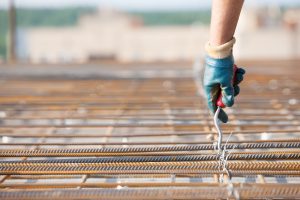
Steel rebar or reinforcement is used in concrete to compensate for its low tensile strength. The steel used for this purpose in reinforced concrete structures is in the form of wire or rebar and is called rebar steel. Classification of rebar steel In different countries, rebar steels are produced with different standards, and in each standard there is a specific classification related to the mechanical properties of steels. In different countries, rebar steels are produced with different standards, and in each standard there is a specific classification related to the mechanical properties of steels.
Rebar steel produced in Iran is divided into three groups: A-1 type steel Steel type A-2 Steel type A-3 A-1 steel is of smooth type and its yield strength and tensile strength are 2300 and 3800 kg/cm2 respectively. A-2 steel is ribbed with a yield strength of 3000 and a tensile strength of 5000 kg/cm2. And A-3 steel is ribbed with a yield strength of 4000 and a tensile strength of 6000 kg/cm2. Raw materials used differ depending on the type of product. The rolling parts of the beam – studs and corners use 3sp ingots and 5sp ingots are used for rebar rolling (3sp and 5sp ingots are different in the analysis). Ingots are produced in different dimensions depending on the design and type of preheat furnaces and rolling lines. Usually, the ingots are 6000*150*150 or 6000*125*125. If the length of the ingots is 12 meters, then in the factory they cut the ingots into specific lengths according to the capacity and dimensions of the furnace. Rolling on steel is one of the most common jobs. One of the methods of forming metals is the rolling process, in other words, the process of changing the shape of metal by passing between rollers is called rolling, which is done in two ways, hot and cold. Cold rolling: changing the shape of metal at ambient temperature Hot rolling: deformation at a temperature higher than the ambient temperature and lower than the melting temperature of the metal Rolling is one of the most common metalworking processes because its production is high and the control of the final product is precise. In changing the shape of the metal between the rollers and as a result of applying the pressure of the rollers, a lot of compressive stress is applied to the piece. Frictional forces also cause the metal to be drawn into the rollers. The first conversion of ingots into ingots is generally done by hot rolling.
INTERNATIONAL SPECIFICATIONS:
| Sl No |
International Standard/Grade |
Application |
| 01 |
BS:4449-1997 Grade 460B |
Concrete reinforcement |
| 02 |
BS:4449-2005 |
Concrete reinforcement |
| 03 |
ASTM A615 Grade 40/60/75 |
Concrete reinforcement |
| 04 05 |
SSA 2/1992 ASTM A1035 |
Concrete Reinforcement Low-alloy High Strength Corrosion resistance rebar for concrete reinforcement |
| 06 |
ASTM A706 Grade 60/Grade 80 |
Low-Alloy Steel earth-quake resistance rebar for concrete reinforcement |
Note: Other specifications as per any international standard or meeting any other special requirement can be supplied as per customer’s requirement.
LINEAR MASS AND NUMBER OF REBARS IN 2 MT
| Diameter in mm |
Nominal Weight per unit length in Kg/M |
Nominal Cross-section Area (mm2) |
Minimum number of bars in 12 M length (-0/+100 mm) of 2 MT bundle |
| 8 |
0.395 |
50.27 |
422 |
| 10 |
0.617 |
78.54 |
270 |
| 12 |
0.888 |
113.1 |
188 |
| 14 |
1.210 |
153.9 |
138 |
| 16 |
1.580 |
201.1 |
105 |
| 18 |
2.000 |
254.5 |
83 |
| 20 |
2.470 |
314.2 |
67 |
| 22 |
2.980 |
380.1 |
56 |
| 25 |
3.850 |
490.9 |
43 |
| 28 |
4.830 |
615.8 |
34 |
| 32 |
6.310 |
804.2 |
26 |
| 36 |
7.990 |
1017.9 |
21 |
| 40 |
9.864 |
1256.6 |
17 |




